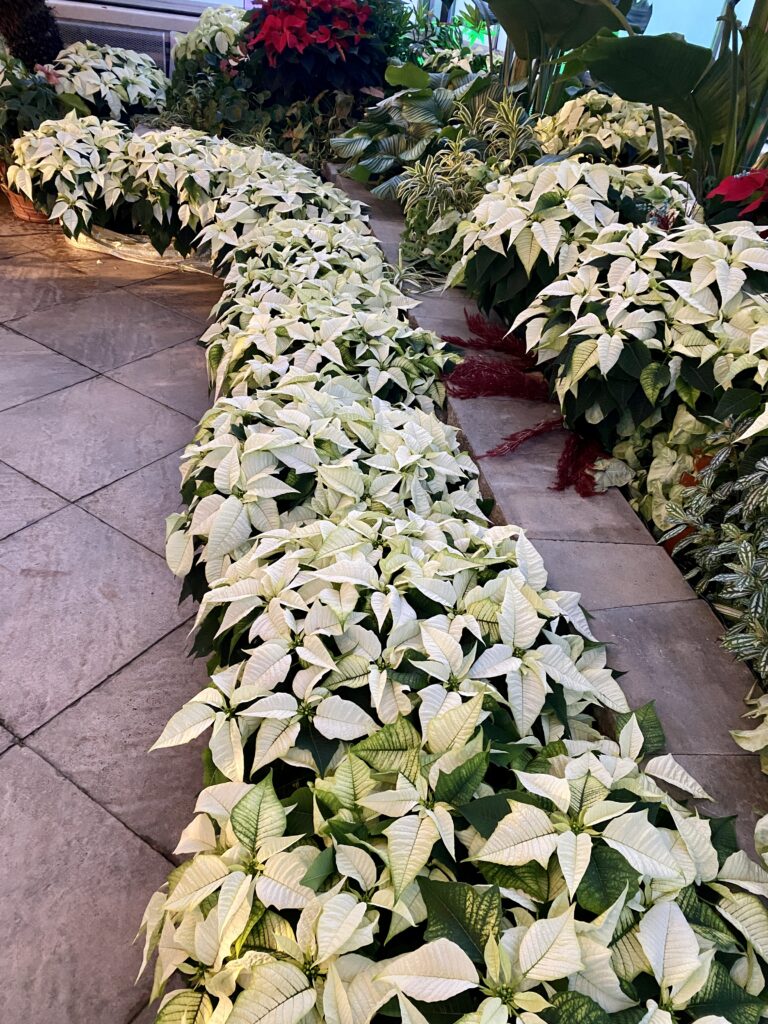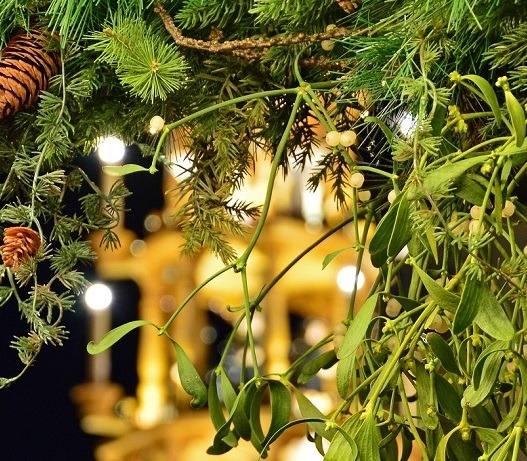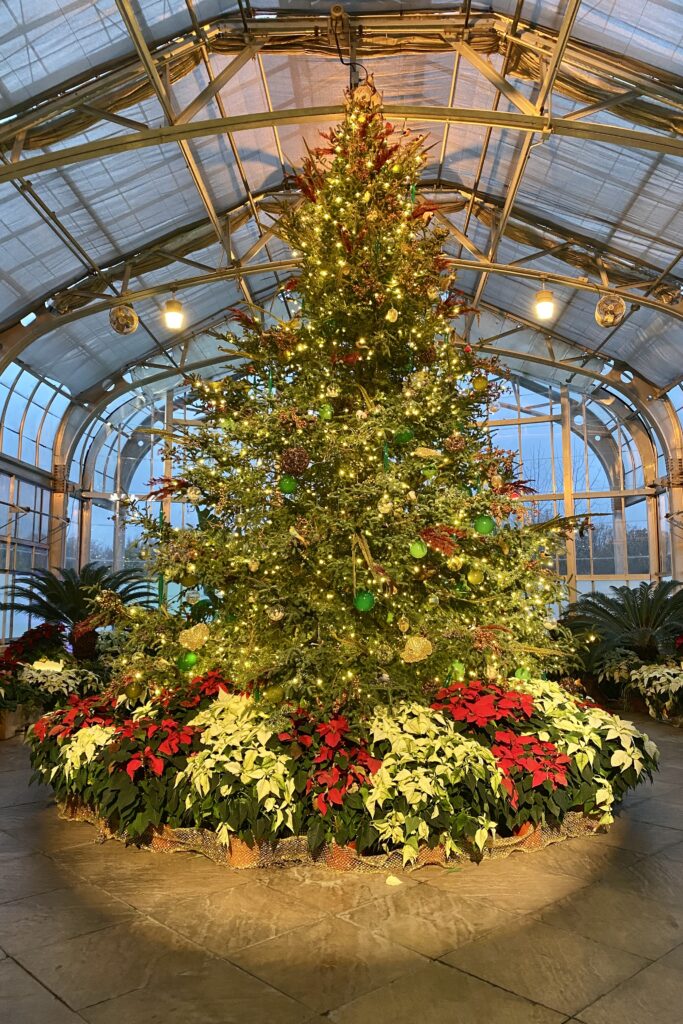The Legends and Lore Behind Holiday Greenery
The holly, mistletoe, poinsettias and pine we decorate with this time of year have their own backstories that tell of mythical beginnings and magical powers.
We have been bringing evergreens indoors for thousands of years, beginning with the celebration of the winter solstice. For many ancient civilizations, evergreens were a symbol of life – the plants kept their color year-round, and with it the promise of protection from the brutal winter and the potential of new life in the coming spring. And because different cultures marked the solstice in different ways, many evergreens grew to have more than one origin story.
Let’s take a look at some of the most beloved narratives – stories that, like the evergreens themselves, abide.
Mistletoe
There was a time when the Norse god Balder was plagued with constant nightmares that foretold of his impending death. His mother Frigg, goddess of love and beauty, set out to protect her son by requiring every living thing on earth to swear an oath never to harm him. Only the mistletoe was not bound by Frigg’s decree – she believed that it was too young to swear.
The evil god Loki, jealous of Balder’s new invincibility, took advantage of the goddess’s oversight. He arranged for Balder to be shot with a tiny mistletoe twig which killed him instantly. As Frigg’s tears of grief fell like pearly white berries onto the mistletoe, the heartbroken mother declared that the plant would never again be used for death. Mistletoe would become a symbol of love, and whomever stood beneath it would receive a kiss.
In Central Virginia, American Mistletoe grows overhead in the branches of some 100 different species of hardwood. It is a parasitic plant that extracts all of the nutrients it needs from the trees that serve as its host.
Mistletoe blooms between February and March, its tiny flowers giving way to clusters of waxy white berries in early spring. Inside each berry is a single, sticky seed. When unsuspecting birds eat the berries and pass the seeds, the seeds anchor themselves to branches below, where they germinate and tap into the vascular tissue of their host, consuming water, minerals, nitrogen compounds, and energy-rich carbon compounds and earning themselves the name Phoradendron leucarpum, or “thief tree.” (American mistletoe can cause gastrointestinal distress if swallowed, although it is not likely to cause serious poisoning in small amounts.)
Sources:
Dunn, Robb. 2011, December 21. “Mistletoe: The Evolution of a Christmas Tradition.” Smithsonian Magazine.
Perry, Leonard. 2019.“Holiday Greens and Their Traditions.” University of Vermont Extension Department of Plant and Soil Science
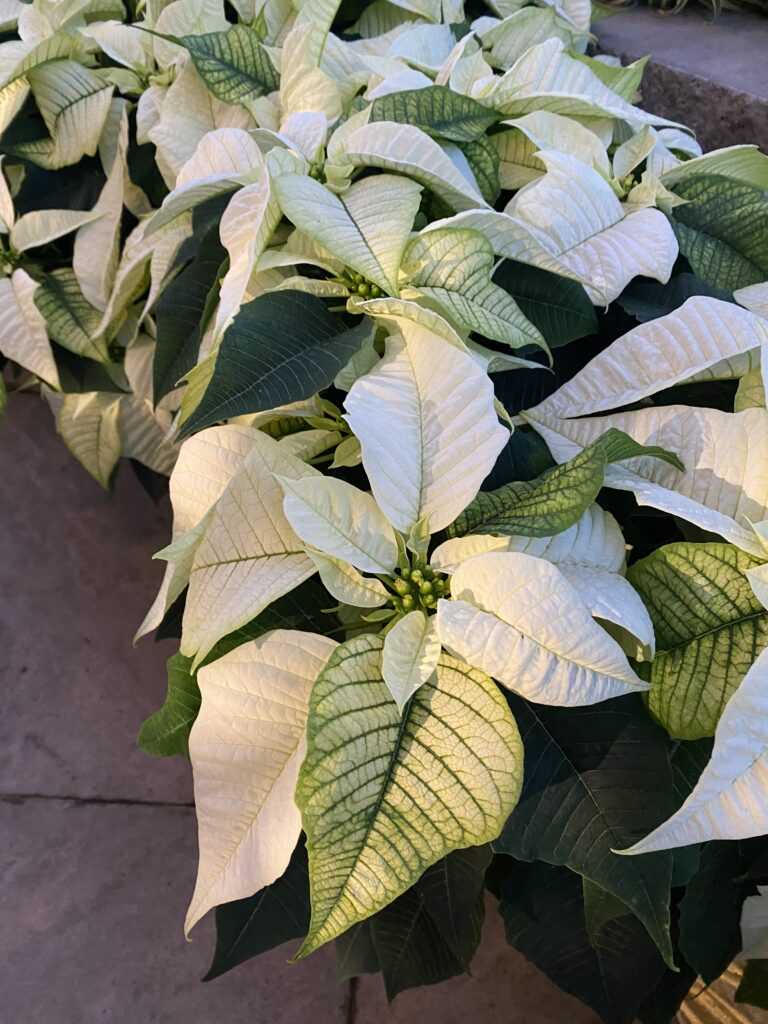
Growers around the world prepare tens of millions of poinsettias for the holiday season each year. photo by Meredith Orne
Poinsettia
Travelling on foot to the annual Christmas eve service, a poor Mexican girl named Pepita gathered a bouquet of weeds that she found growing along the roadside. It was all she had to offer to the baby Jesus. Arriving at the church, Pepita laid her bouquet at the feet of the Christ child and the weeds burst instantly into bright red flowers. From that night on, the poinsettia was known as “Flores de Noche Buena,” or “Flowers of the Holy Night.”
The petal-shaped poinsettia leaves that we prize for their holiday color are in fact bracts – modified leaf structures that grow just beneath the actual flower, attracting pollinators and protecting the tender inflorescence from other forces of nature.
Growers around the world prepare tens of millions of poinsettias for the holiday season each year by withholding sunlight, which prevents the production of chlorophyll. Without chlorophyl, the bracts absorb green light and reflect red light into our eyes, making the bracts appear as red, pink or white, depending on the variety of poinsettia. It’s the same process that transform summer’s green leaves into the reds, oranges and yellows of autumn.
In Central Virginia, poinsettias can be kept as houseplants year-round. They prefer to be watered when the soil surface feels dry, fertilized every 3-4 weeks when new growth appears, bathed in bright sunlight and kept in 65–70-degree temperatures.
To force poinsettias to “rebloom” at home, refer to this easy month-by-month guide that requires only fertilizer, pruning shears, a dark closet and some timely attention.
Sources:
Caviness, Crystal. 2019, December 16. “The poinsettia: Jesus’ life story in a plant.” United Methodist Church.
The Forest Service, US Department of Agriculture
Weisenhorn, Julie. 2020. “Growing and Caring for Poinsettias.” University of Minnesota Extension Department of Horticulture
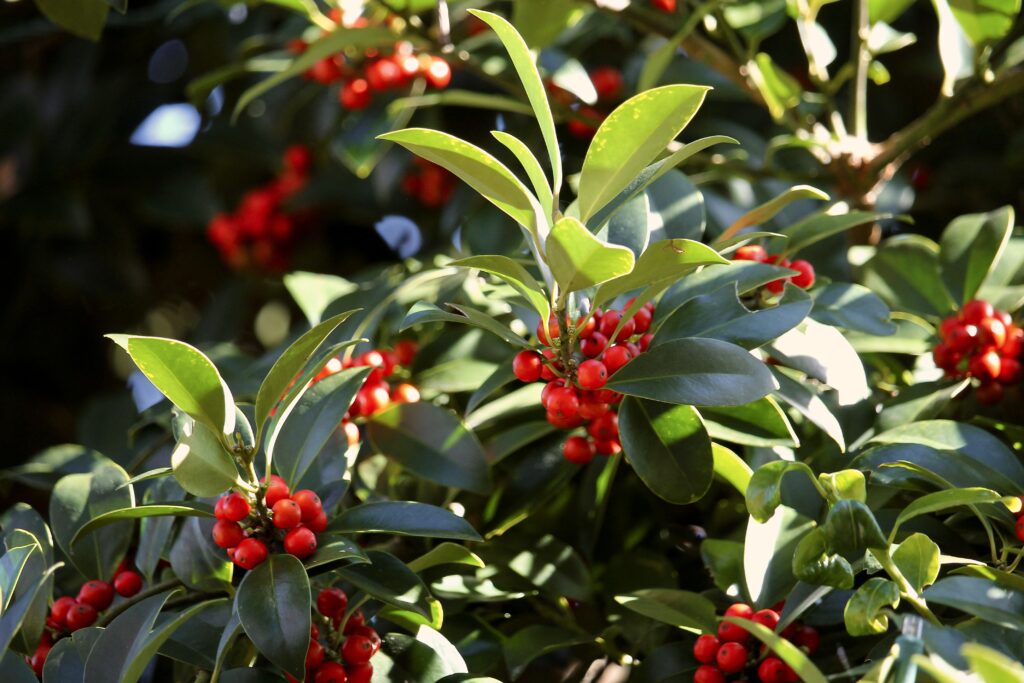
A Virginia native evergreen, holly prefers moist, well-drained, acidic soil with a high organic content. photo by Meredith Orne
Holly
The wreaths, candles, feasting and gift-giving that we associate with Christmas were all originally part of the pagan celebration of Saturnalia, a week of festivities honoring the god of agriculture, abundance and renewal. Christian citizens who chose not to worship the pagan god Saturn were executed for their defiance. To protect themselves from persecution, they adopted holly as ornamentation during the Saturnalia festivities, secretly altering its symbolism to honor their own beliefs. The sharp spines along the holly leaf edges represented the crown of thorns that Christ wore; the red holly berries signified drops of his blood. Although early Christians didn’t celebrate the birth of Jesus, they were recognizing his sacrifice at the crucifixion.
Only the female holly bears the bright red berries that appeal to hungry wildlife and holiday decorators. But because the species is dioecious, fruit production requires a nearby male that flowers at the same time as the female. (Many cultivars are given gender-appropriate names such as “China Boy” and “Jersey Princess” to guide the guileless gardener in making the right choice.)
A Virginia native evergreen, holly prefers moist, well-drained, acidic soil with a high organic content. It will thrive in full sun or partial shade and appreciates protection from winter sun and wind. American holly, (Ilex opaca), matures into a tidy conical shape that can reach a height of 40-60 feet. When it reaches 4-5 years of age, it will tolerate pruning in late fall or early winter – just in time to collect the cut branches and deck the halls. Bear in mind that holly berries can cause nausea, vomiting and diarrhea if eaten.
Sources:
Fishburn, Jennifer. (2019, December 6.) “Growing holly.” University of Illinois Urbana-Champaign Extension College of Agricultural, Consumer, & Environmental Sciences
Jubela, Joan. 2022, November 15. “Holly: Legends, Customs, and Myths.” Penn State Extension
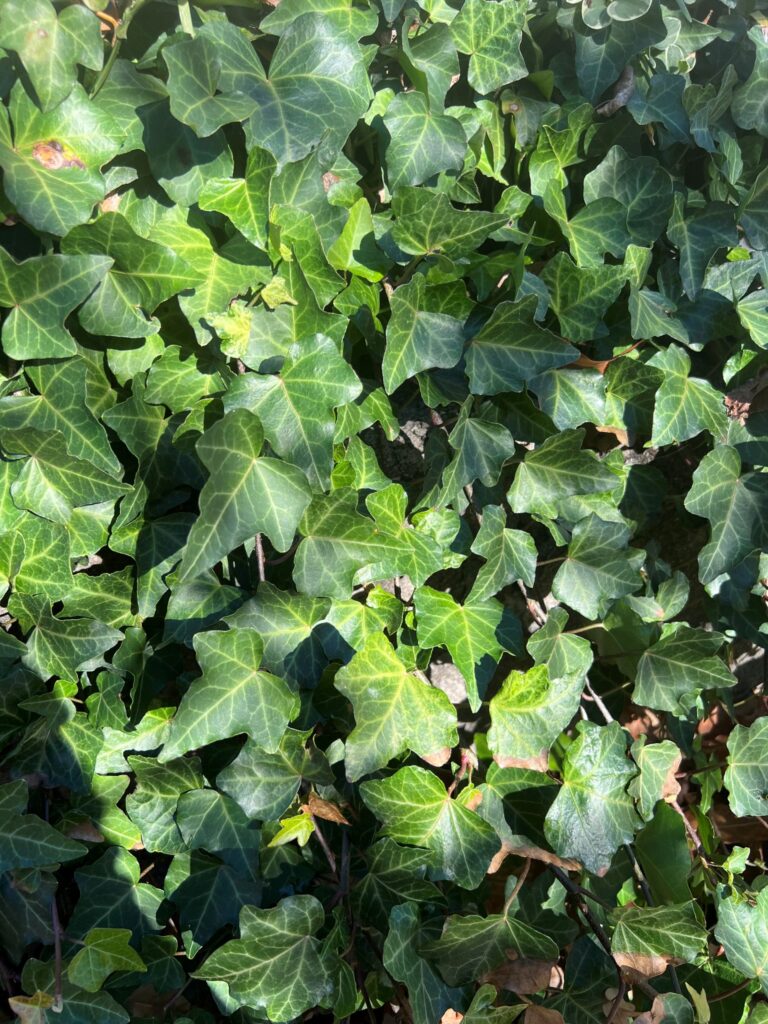
Early Christians associated ivy with eternal life and the immortal nature of the human soul. photo by Leigh Crandall
Ivy
Roman revelers who over-imbibed during the annual two-week celebration of Baccus wore crowns of ivy to protect themselves from the aftereffects of their indulgences. Bacchus was the god of forests, vegetation and fruitfulness. His domain extended beyond the growing of grapes to their harvest and the making of wine. Logically, he was also associated with revelry, intoxication, freedom, ecstasy, and fertility. Baccus himself was often depicted wearing a wreath of ivy and grapevines to ward off his own intoxication.
Early Christians associated ivy with eternal life and the immortal nature of the human soul. At Christmastime, the glossy green vine came to symbolize prosperity and charitable giving.
Plant ivy indoors in a well-draining container filled with rich potting mix. Water when the soil feels dry to the touch and feed monthly with foliage fertilizer during the growing season. To raise the humidity level, set potted ivy in a shallow tray lined with small pebbles immersed in shallow water. Bright indirect light will encourage the contrasting splashes of silver, gray-green, white, cream, yellow, chartreuse or gold that distinguish ornamental ivies from their less colorful relatives. Although English ivy produces harmless levels of a toxic agent known as saponin, it is not considered to be dangerous in small amounts.
Christmas Tree
The modern-day Christmas tree began as a prop in a Medieval stage play. Actors portraying Adam and Eve performed around a “paradise tree” set in the Garden of Eden – a live fir hung with apples to represent the tree of knowledge. Later, the “paradise tree” became a tradition in Germany when it was hung with Communion wafers on December 24 to celebrate the feast day of Adam and Eve. Candles were sometimes added to represent Christ as the light of the world, and eventually cookies came to replace the wafers. Often, a “Christmas pyramid” was displayed in the same room. Branches stacked in the shape of a pyramid were decorated with evergreens, candles, and a collection of small figurines, and topped with a single star. By the 16th century, the “paradise tree” and the “Christmas pyramid” had become one, and the tradition of the Christmas tree was born.
Britannica. 2023, November 27. “Christmas Tree.”
Holiday Safety
In days of yore, it was believed that bringing holly, ivy, mistletoe and other holiday evergreens into the home before Christmas Eve would condemn the household to a year of bad luck. Holiday safety today still starts with fresh plant material today. Cut greenery from your own yard or from the yard of a generous friend, trim the stem ends at a 45° angle and store them in fresh water in a cool, dark place. Just before decorating, submerge the entire cutting in a bathtub of water for up to 24 hours. Then mist daily, front and back, focusing on the stem ends but moistening the entire arrangement. Always keep greens away from direct sunlight or a heat source, and replace them with fresh greens when they start to dry out.
“The Holly and the Ivy.” 2009, December 1. University of Missouri.
